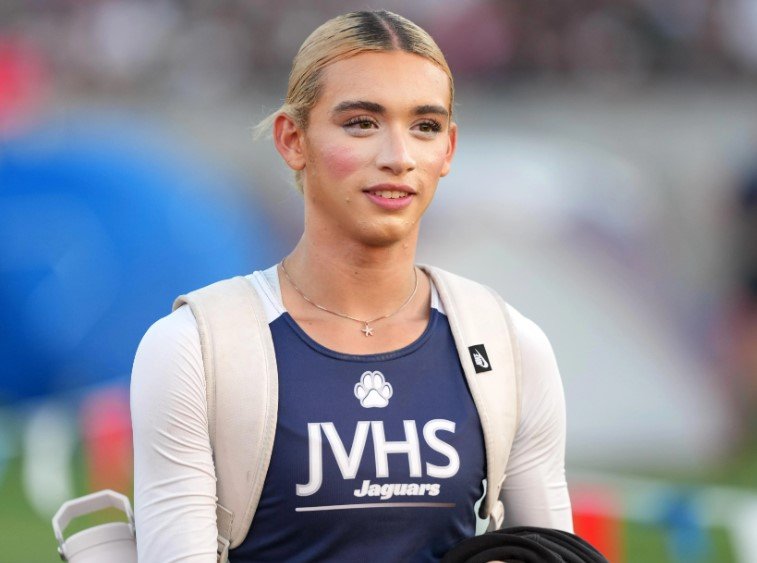President Donald Trump stirred the pot again Tuesday morning, threatening California Governor Gavin Newsom with heavy fines over the participation of a transgender athlete in girls’ high school track events. This latest showdown has reignited debates around transgender rights and sports fairness in one of America’s most politically charged battlegrounds.
Trump’s Threat Sparks New Fire in Transgender Athlete Debate
Early Tuesday, Trump took to Truth Social with a pointed message directed at Governor Newsom. “A Biological Male competed in California Girls State Finals, WINNING BIG, despite the fact that they were warned by me not to do so,” Trump wrote. He went on to warn of “large scale fines” being imposed if the situation wasn’t rectified. The misspelling of Newsom’s name as “Newscum” was noted widely online, adding to the viral nature of the post.
The athlete in question is 16-year-old AB Hernandez, a transgender female who won gold in both the girls’ high jump and triple jump events at the California high school track and field championship over the weekend. Hernandez’s victories have been at the center of a firestorm, stirring a mix of support and opposition across social media and political platforms.
Trump’s post came just days after the California Interscholastic Federation (CIF), which oversees high school sports in the state, updated its competition rules. The CIF adjusted eligibility guidelines to allow more cisgender girls the opportunity to compete and medal in events where Hernandez participated. This move was seen as a direct response to Trump’s prior threats to cut federal funding to California unless transgender athletes were excluded from girls’ sports.
The tension illustrates how deeply divided the issue of transgender participation in athletics remains—not just in California but nationwide.

The California Response: Rules, Rights, and Backlash
California has long been considered a leader in protecting LGBTQ+ rights, making the CIF’s rule adjustments all the more significant. While the CIF’s decision to tweak eligibility standards aimed to balance fairness and inclusivity, it was met with immediate criticism from various groups.
Some see the rule changes as a necessary step to ensure fair competition. Others argue it unfairly targets transgender athletes, marginalizing a vulnerable community. For AB Hernandez and supporters, these new regulations feel like a direct attack on their identity and hard work.
Governor Newsom, while yet to comment directly on Trump’s latest threat, has previously voiced support for transgender rights in California. His administration has worked to safeguard protections for transgender youth, including access to sports, healthcare, and education.
Yet, Trump’s post and his call for large-scale fines put Newsom and California in a tough spot. Federal funding threats carry significant weight, especially in a state with billions of dollars in federal aid. How Newsom responds in the coming days could shape the state’s stance and national conversations on transgender athletes.
National Implications and Industry Reactions
This showdown is far from an isolated spat between two political figures. It echoes a larger national debate playing out in legislatures, school districts, and sports organizations across the country.
Recently, several states have passed laws restricting transgender athletes from competing in sports aligned with their gender identity. These laws often cite concerns over fairness and safety. Meanwhile, advocates for transgender rights argue that such laws harm young people already facing high rates of discrimination and mental health challenges.
In sports, governing bodies like the NCAA and the International Olympic Committee have also wrestled with how to include transgender athletes fairly. The evolving science around physical advantages, hormone therapy impacts, and individual rights complicates decisions further.
Trump’s threat to impose fines on a state level adds a new twist—federal pressure on states that uphold transgender participation rights could become a political lever. It also raises questions about states’ rights and federal overreach.
What Does the Data Say About Transgender Athletes in Sports?
The debate often comes down to questions about fairness and physical advantage. Research is still emerging, but here’s a snapshot of key points:
| Factor | Findings |
|---|---|
| Muscle mass and strength | Transgender women on hormone therapy generally experience reductions but may retain some advantages. |
| Performance gaps | Studies show mixed results; some transgender athletes outperform cisgender peers, others do not. |
| Policy diversity | Different sports organizations have varied guidelines based on testosterone levels and transition timelines. |
Experts caution against sweeping generalizations. Each athlete’s situation is unique, making blanket bans or allowances difficult to justify scientifically.
Public Opinion and Political Crosscurrents
Polling data reflects a divided public. A recent Gallup poll found:
-
55% of Americans support transgender athletes competing in line with their gender identity.
-
40% oppose it, citing concerns about fairness.
Political divides are clear. Democrats tend to support inclusion policies, while Republicans often push for restrictions.
This controversy highlights how sports—traditionally a unifying force—are increasingly becoming battlegrounds for cultural wars. The personal stories of athletes like AB Hernandez get caught in the middle.
Trump’s blunt call for fines and threats to cut funding show how this issue isn’t just about sports. It’s about identity, politics, and power. Whether California stands firm or folds to pressure remains to be seen. But one thing’s for sure: this debate isn’t going away anytime soon.








